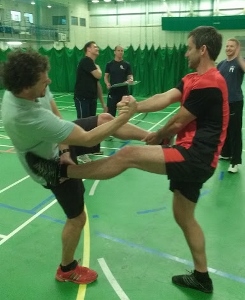Get the dumbbells moving
“Move the dumbbells as far away from your body as possible”
when doing reverse flyes. Or “lower and retract shoulder blades whilst body is at a 30 degree angle and work in the transverse and horizontal planes with maximal extension“.
Which is better for motor learning?
This proved an interesting sidebar on the level 1 strength and conditioning for sport assessment on Saturday in Wellington.
Giving instruction and feedback used to be mainstays of coaching practice: in fact they are still prevalent.
“Your knee is dropping, lift it higher” would be an example. The coaches on the assessment day at a pretty good eye for spotting errors, and then giving an instruction. This may see an immediate improvement in that practice session.
However, motor learning research has developed over the last 15 years, and we now understand that getting the athlete to solve problems aids learning. This then transfers beyond the practice into competition itself (This could be called athlete centred learning, although I see that misinterpreted into just playing games at every opportunity).
Think outside of the body
 “The task determines the muscle’s activation pattern, and not the other way round.” Eyal Lederman. If you try and touch a point on the wall as high as you can, your body will extend itself.
“The task determines the muscle’s activation pattern, and not the other way round.” Eyal Lederman. If you try and touch a point on the wall as high as you can, your body will extend itself.
Terms like “engage” or “activate” may get the muscle to work, but who cares if there is no transfer to the movement we want?
“We train movements not muscles” Vern Gambetta. This was reinforced time and time again on the course. Train the movement and the muscles look after themselves.
Strength and conditioning can often default to a sets/reps recital from a spreadsheet: but I am a coach, and so were the people on the assessment day.
If you want any of these exercises to transfer beyond the gym, we have to get the athletes solving the problems themselves (which we as coaches set) and making decisions.
John Brierley covered this well “How to acquire skill in strength and conditioning”
Well done to all the candidates, they passed the theory and practical. We finished up with a look at continuing professional development: a discussion around different ways to learn and develop as coaches.
Thanks to Princess Royal Sports Complex for hosting.

I attended this weekend, and between everyone on course it was quickly spotted that every coach/ sport as their own ideas on how the body should move, with very different terms and saying on how to move. However when we all asked questions, used simple terms, and everyday objects to get our own ideas across to each other, for the movements we wanted others to do, the rest of the day went smoothly. What I took away from the weekend, never think the person(s) you coach know what you know,what ever their level. Get the player to answer the question of why they may not be doing the movement correctly . And coach movements not muscles.